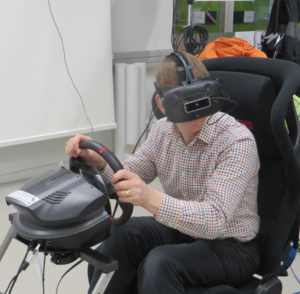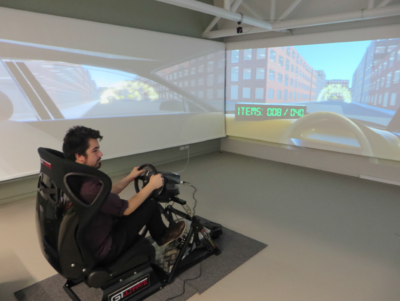VRroom

A project to compare peripheral vision between CAVE and headset VR.
We compared a VR headset against a CAVE environment in a driving task to ascertain both the importance of peripheral vision in the task and the subjects' perception of the differences between the headset and the CAVE. Our hypothesis is that the wider peripheral vision in the CAVE environment will produce better performance than the VR headset. Our experimental results from 2017 showed that subjects perceive qualitatively that their performance in the CAVE is better than in the headset, but that this is not borne out by the quantitative data.
Virtual reality headsets have been in use for decades, becoming popular and widely accessible in the last couple of years. However, they have drawbacks that mean it is not clear that they will ever be more than a niche product: the user is isolated from the real world, is disconnected from seeing their own body, and lacks peripheral vision. This work compares a VR headset against a multi-screen CAVE VR, which suffers from none of these three drawbacks. We use a driving simulator task where we aim to keep as much of the rest of the environment as similar as possible. In particular, the user has a tactile interface (seat, steering wheel, pedals) that is identical in both scenarios and is familiar to anyone who has driven a car.
Experimental setup

We wrote a driving simulator system that allowed us to create a driving task in which peripheral vision could be important. The task was to drive around a computer-rendered city, searching for and collecting objects, which are often located down side-streets. The buildings are sufficiently tall that the driver cannot easily see what is down a side-street until they are at a junction. The task we settled on was a city-scape version of Pacman, with the driver having to find and pick up all of the pac-dots. The intention was that the driver would need to look down side streets frequently to check whether they have collected them all.
To refine the task, we conducted early informal trials with the computer graphics team, who were aware of the aim of the project. Once we were happy with the task, we then ran it on subjects (who were unaware of the aims of the project. We got noticeably different results from those uninformed subjects than from the informed experts.
Conclusions
Having constructed a task in which peripheral vision should have been helpful, we found that there was no statistically-significant difference between the 270° field-of-view CAVE context and the 110° field-of-view HMD context.
If we are to tease out whether peripheral vision is important in driving, then further tests need to be run, which may involve the following:
- running the same experiment modified to make U-turns more time-efficient than driving round the block;
- running a similar experiment entirely in the CAVE environment with a face mask to modify the subject's field-of-view;
- designing alternative experiments that dispense with the driving simulation and concentrate on artificial tasks designed to test use of head-turns and peripheral vision;
- running experiments in which subjects are randomly briefed or not briefed on the use of peripheral vision in the task, to see whether briefing affects the ability to use peripheral vision.
 A project to compare peripheral vision between CAVE and headset VR.
We compared a VR headset against a CAVE environment in a driving task to ascertain both the importance of peripheral vision in the task and the subjects' perception of the differences between the headset and the CAVE. Our hypothesis is that the wider peripheral vision in the CAVE environment will produce better performance than the VR headset. Our experimental results from 2017 showed that subjects perceive qualitatively that their performance in the CAVE is better than in the headset, but that this is not borne out by the quantitative data.
Virtual reality headsets have been in use for decades, becoming popular and widely accessible in the last couple of years. However, they have drawbacks that mean it is not clear that they will ever be more than a niche product: the user is isolated from the real world, is disconnected from seeing their own body, and lacks peripheral vision. This work compares a VR headset against a multi-screen CAVE VR, which suffers from none of these three drawbacks. We use a driving simulator task where we aim to keep as much of the rest of the environment as similar as possible. In particular, the user has a tactile interface (seat, steering wheel, pedals) that is identical in both scenarios and is familiar to anyone who has driven a car.
A project to compare peripheral vision between CAVE and headset VR.
We compared a VR headset against a CAVE environment in a driving task to ascertain both the importance of peripheral vision in the task and the subjects' perception of the differences between the headset and the CAVE. Our hypothesis is that the wider peripheral vision in the CAVE environment will produce better performance than the VR headset. Our experimental results from 2017 showed that subjects perceive qualitatively that their performance in the CAVE is better than in the headset, but that this is not borne out by the quantitative data.
Virtual reality headsets have been in use for decades, becoming popular and widely accessible in the last couple of years. However, they have drawbacks that mean it is not clear that they will ever be more than a niche product: the user is isolated from the real world, is disconnected from seeing their own body, and lacks peripheral vision. This work compares a VR headset against a multi-screen CAVE VR, which suffers from none of these three drawbacks. We use a driving simulator task where we aim to keep as much of the rest of the environment as similar as possible. In particular, the user has a tactile interface (seat, steering wheel, pedals) that is identical in both scenarios and is familiar to anyone who has driven a car.
 We wrote a driving simulator system that allowed us to create a driving task in which peripheral vision could be important. The task was to drive around a computer-rendered city, searching for and collecting objects, which are often located down side-streets. The buildings are sufficiently tall that the driver cannot easily see what is down a side-street until they are at a junction. The task we settled on was a city-scape version of Pacman, with the driver having to find and pick up all of the pac-dots. The intention was that the driver would need to look down side streets frequently to check whether they have collected them all.
To refine the task, we conducted early informal trials with the computer graphics team, who were aware of the aim of the project. Once we were happy with the task, we then ran it on subjects (who were unaware of the aims of the project. We got noticeably different results from those uninformed subjects than from the informed experts.
We wrote a driving simulator system that allowed us to create a driving task in which peripheral vision could be important. The task was to drive around a computer-rendered city, searching for and collecting objects, which are often located down side-streets. The buildings are sufficiently tall that the driver cannot easily see what is down a side-street until they are at a junction. The task we settled on was a city-scape version of Pacman, with the driver having to find and pick up all of the pac-dots. The intention was that the driver would need to look down side streets frequently to check whether they have collected them all.
To refine the task, we conducted early informal trials with the computer graphics team, who were aware of the aim of the project. Once we were happy with the task, we then ran it on subjects (who were unaware of the aims of the project. We got noticeably different results from those uninformed subjects than from the informed experts.
